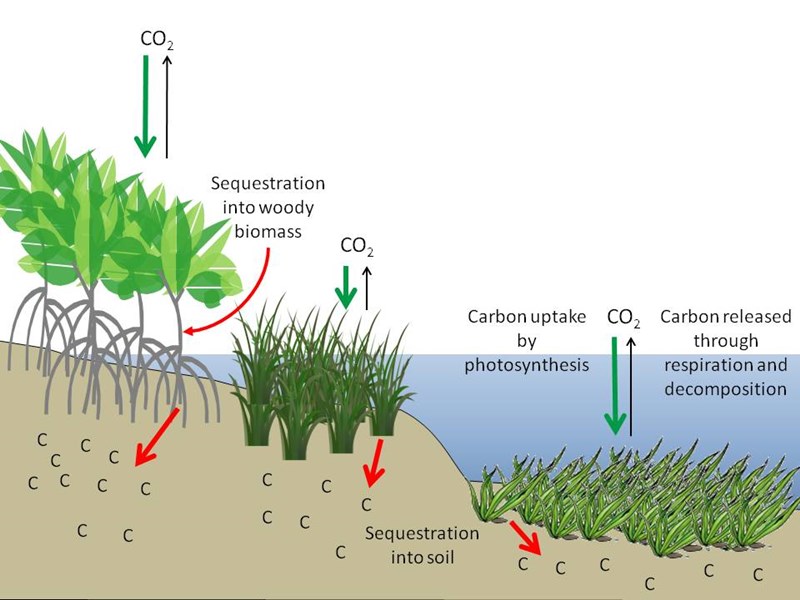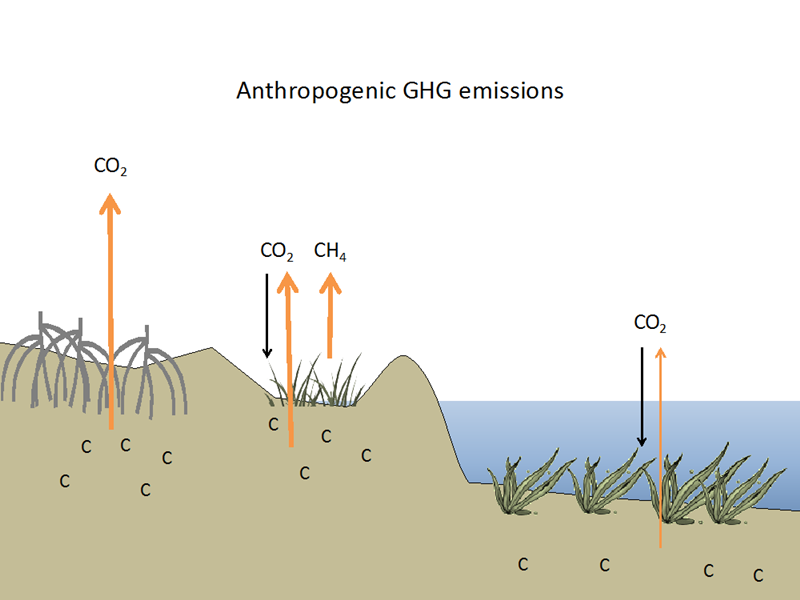Strengthening Coastal Community Resilience in the face of Climate Change: Science to Better Understand, Measure, and Value Coastal Ecosystem
Research Topic:
Environmental Decision Support Science
Task Leader:
Ariana Sutton-Grier
CICS Scientist:
Ariana Sutton-Grier
Sponsor:
NOS
Published Date:
9/29/2017
2017 ANNUAL REPORT
Background
This report summarizes the third year of the NOAA project entitled, “Strengthening Coastal Community Resilience in the face of Climate Change.” This project’s goal is to provide science to support coastal resilience efforts with a particular focus on ecosystem services such as coastal blue carbon and the storm protection benefits provided by natural infrastructure (i.e., healthy coastal ecosystems), as well as the connections between ecosystems and human health.
Accomplishments
This project has had a very productive third year. Four publications about ecosystem services were published (one is in press), and I gave nine talks (all of which were invited presentations including 2 webinars and 1 Capitol Hill briefing). This project has also advised 2 graduate student research projects (one doctoral student at the Universite de Bretagne Occidentale, in the Ecole Doctorale des Sciences de la Mer in France, and one Master’s student at the College of Charleston)and 1 undergraduate project (1 Socio-Environmental Synthesis Center (SESYNC) summer intern at UMD). The research articles published from all three years of this project have been cited 167 times already.
I also was an invited participant in the SESYNC Workshop on how to improve teaching of socioenvironmental synthesis. As part of that workshop I created a summary of the Jigsaw method for teaching about SE synthesis. (See: https://www.sesync.org/the-jigsaw-method-and-cooperative-learning).
This project has also contributed to significant natural resource policy and climate policy goals for the U.S. federal government including climate policy as well as U.S. coastal resilience efforts. One publication from this project that has had a particularly important policy impact was the “Future of Our Coasts” publication in the journal Environmental Science and Policy. This publication won the 2016 Ecological Society of America’s “Innovations in Sustainability Science” Award. The publication also garnered me an invitation to speak at a Capitol Hill briefing organized by Pew on the role of natural infrastructure in coastal resilience. See more info: http://www.esa.org/esablog/ecology-in-the-news/news-events/2016-innovation-sustainability-science-award/
In addition, my research and expertise on coastal blue carbon at NOAA has also had important policy outcomes. I was part of the NOAA-led Coastal Wetlands Carbon Work Group (CWCWG) which was led by NOAA in order to include coastal wetlands into the U.S. national greenhouse gas inventory. This was a 2 year effort begun in 2015 and completed in 2017 with the inclusion for the first time of coastal wetlands in the US submission to the United Nations Framework Convention on Climate Change (UNFCCC) which is out for public review until March 17. (see: https://www.epa.gov/ghgemissions/inventory-us-greenhouse-gas-emissions-and-sinks). This is a big step forward because now that coastal wetlands are included, they need to be included every year which means the U.S. will need to continue to track the management, restoration, and loss of coastal wetlands every year into the foreseeable future. Hopefully this tracking will result in opportunities for better management and more restoration and it sets an example for the rest of the world about the importance of tracking and managing coastal wetlands.


Figure 1: Graphics from the Howard and Sutton-Grier et al. (2017) showing the carbon dynamics in healthy coastal wetlands that sequester carbon long-term in their soils, and how they become additional anthropogenic sources of carbon when these ecosystems are degraded.
I co-led an article on coastal ecosystems and climate mitigation in Frontiers in Ecology and Environment which was also featured in a Restore America’s Estuaries webinar (See Figure 1 and Howard and Sutton-Grier et al., 2017). This article clarifies why climate mitigation efforts should focus on protecting and restoring coastal wetland ecosystems and why other coastal and marine ecosystems (including corals, kelp, phytoplankton, and marine fauna) are not good candidates to help with natural climate mitigation opportunities.
I also was invited to participate in the National Center for Ecological Analysis and Synthesis (NCEAS) Science for Nature and People Partnership (SNAPP) work group on coastal restoration which is running 2016-2018. (See website: https://www.nceas.ucsb.edu/projects/12721). This group has met twice (May 2016 and Jan 2017) and we will meet 1-2 more times to complete the publications and projects we are jointly working on related to assessing the state of coastal restoration in the U.S., identifying barriers to more restoration and suggesting ways to overcome those hurdles.It has been a very exciting and productive third year of this project.
Planned work
-
Submit manuscript on storm protection services in the Natural Resources and Damage Assessment (NRDA) process (with colleagues from NOS OR&R); the manuscript has gone through NOAA review and we are just waiting for final approval to submit to Marine Policy (this was submitted 3/22/17 and is in review now)
-
Complete final revisions on a book chapter on how blue carbon can be incorporated into national policies
-
Complete two publications on the process of doing the incorporation of coastal wetlands into the U.S. national greenhouse gas inventory
-
Continue participation in the Science for Nature and People Partnership (SNAPP) team out of the National Center for Ecological Analysis and Synthesis (NCEAS) (Spring 2016-Spring 2018)
-
Present on blue carbon at the Society of Wetlands Scientists meeting (June, 2017) and on the impacts of disasters on ecosystem services and subsequently on human health at the annual Ecological Society of America conference (August, 2017) in a session I organized on the links between biodiversity and ecosystem services in coastal environments
-
Finish up the research project effort to connect U.S. policy opportunities to the NASA-funded research project linking satellites to field measurements of coastal carbon
-
Co-mentor 2 Hollings Scholars to work on coastal resilience science policy and blue carbon (Summer, 2017)
Publications
+Denotes co-first authored publication
Sandifer, P., L. Knapp, T. Collier, A. Jones, R. Juster, C. Kelble, R. Kwok, J. Miglarese, L. Palinkas, D. Porter, G. Scott, L. Smith, W. Sullivan, and A. Sutton-Grier. 2017. A conceptual model to assess stress-associated health effects of multiple ecosystem services degraded by disaster events in the Gulf of Mexico and elsewhere. Geohealth 1:1-20. doi:10.1002/2016GH000038.
Howard, J., A.E. Sutton-Grier+, D. Herr, J. Kleypas, E. Landis, E. Mcleod, E. Pidgeon, S. Simpson. 2017. Clarifying the role of coastal and marine systems in climate mitigation. Frontiers in Ecology and Environment. 15(1):42-50. DOI: 10.1002/fee.1451.
Polefka, S. and A.E. Sutton-Grier+. 2016. Making ecosystem services part of business as usual in federal governance. Frontiers in Ecology and Environment. 14(4):175. DOI: 10.1002/fee.1267.
Sutton-Grier, A.E.and A. Moore. 2016. Leveraging Carbon Services of Coastal Ecosystems for Habitat Protection and Restoration. Coastal Management. Coastal Management. 44(3):259-277. DOI: 10.1080/08920753.2016.1160206.
Presentations (all invited)
Sutton-Grier, A.E. 2017. “Blue Carbon: The Climate Mitigation Opportunity You’ve Never Heard Of.” NOAA Science Workshop Series, From the Surface of the Sun to the Depths of the Ocean. March 3, 2017.
Howard, J. and A. Sutton-Grier. 2017. “Blue Carbon- What’s in, what’s not, and why.” Webinar for Restore America’s Estuaries. Feb 8, 2017.
Sutton-Grier, A.E. 2017. “Direct Links Between Biodiversity and Human Health.” National Council for Science and the Environment Conference Annual Meeting, Washington,D.C.
Sutton-Grier, A.E. 2016. “The Potential for Managing Coastal Ecosystems to Provide Ecosystem Services and Enhance Resilience.” A Community on Ecosystem Services (ACES) conference, Jacksonville, Florida.
Sutton-Grier, A.E., P. Sandifer, K. Wowk, and H. Bamford. 2016. “Global Change Impacts on Coastal and Ocean Ecosystem Services and Human Health and What We Can Do About It.” Webinar for the Sustainable Adaptive Gradients in Coastal Environments (SAGE) NSF Research Coordination Network.
Sutton-Grier, A.E. 2016. “Policy Opportunities for Promoting Wetland Conservation and Coastal Community Resilience.” Society of Wetland Scientists Annual Meeting, Corpus Christi, Texas.
Sutton-Grier.A.E. 2016. “Advancing Nature-Based Solutions to Coastal Erosion” Capitol Hill briefing, July 6, 2016. Washington, D.C.
Sutton-Grier, A.E. 2016. “Making Your Science Count: Science to Inform Policy and Decision Making.” Society of Wetland Scientists Annual Meeting, Corpus Christi, Texas.
Sutton-Grier, A.E. 2016. “Future of our coasts: Potential for natural and hybrid infrastructure to calm troubled waters.” Part of the session “Bridging Architecture: Extreme Weather and Troubled Waters in Coastal Cities” at the American Institute for Architecture Annual Conference, Philadelphia, Pennsylvania.
Other
· Recipient of the 2016 Ecological Society of America “Innovations in Sustainability Science” Award for the paper, “Future of Our Coasts…”
· Summer 2016 I co-mentored a Socio-Environmental Synthesis Center (SESYNC) undergraduate fellow, Beatrice O’Connor, Summer of 2016 on her project about natural infrastructure for coastal resilience.
· I am currently on the committee of a Master’s student, Rachel Piker, at the College of Charleston.
· I am currently on the Ph.D. advisory committee for Dorothee Herr, at Universite de Bretagne Occidentale, in the Ecole Doctorale des Sciences de la Mer in France
· I was invited to guest lecture as part of a NOAA Science Workshop Series for educators entitled, From the Surface of the Sun to the Depths of the Ocean. I was invited to speak about my work on blue carbon and natural infrastructure. March 2017.
· I was invited for an interview on the radio show “Ocean Currents” out in California on Oct 3, 2016. I spoke about blue carbon. More info: http://cordellbank.noaa.gov/education/radiopodcast2016.html
· I was on the planning committee for the A Community on Ecosystem Services (ACES) bi-annual meeting in Florida. This involved reviewing all the abstracts for acceptance, placing them into themed-sessions, and also reviewing the student travel grant awards.